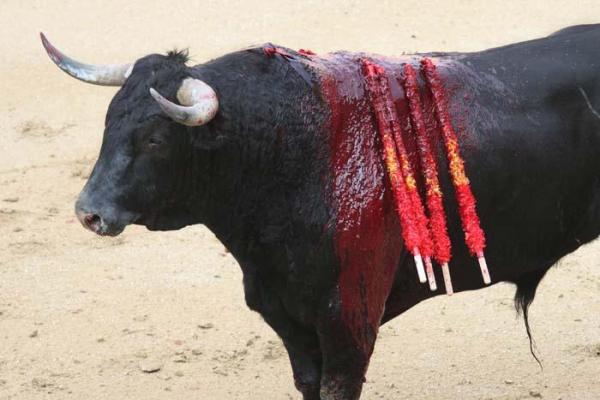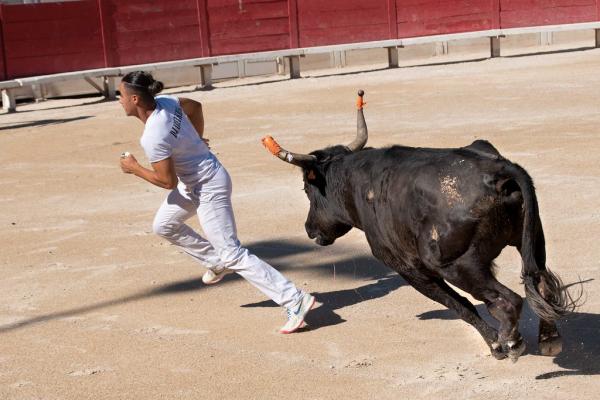Do Bulls Feel Pain in Bullfighting?


The pain suffered by a bull in the bullfighting arena is a controversial topic between bullfighting enthusiasts and those who claim that it is a tradition that should be ended because it involves animal suffering. For pain to occur, first, there must be an unpleasant stimulus. Second, a signal that can be processed and transmitted in a nervous system. Like all other mammals, bulls have a nervous system with nociceptors, the neurons that are specialized to perceive pain. So they are not physiologically exempt from feeling pain, as many claim.
In the following AnimalWised article, we examine whether bulls feel pain in bullfighting, and if so, if it's the same as ours.
What is bullfighting?
In bullfighting, a bullfighter attempts to subdue, immobilize, or kill a bull according to certain rules, guidelines, or cultural expectations.
There are several variations, including those in which a person dances around or jumps over a cow or bull or tries to grab something by its horns. The best known form of bullfighting is Spanish bullfighting, which is practiced in Spain, Portugal, and some countries in Latin America.
Bullfighting is controversial for a number of reasons, including animal welfare, funding, and religious beliefs. There are some forms of bullfighting that are considered blood sports, but in some countries, such as Spain, they are considered cultural events or heritage.
You might be interested in this other article, where we discuss the psychology of animal cruelty.

What is pain?
The International Association for the Study of Pain defines pain as an unpleasant sensory and emotional experience associated with or described as actual or potential tissue damage.
The pain that animals experience is unique to each individual. In other words, pain is subjective. Not only because each of us has a different pain threshold, but because pain is not only a physical symptom, but can also be psychological, social, and therefore affects the natural behavior of animals.
The biological significance of pain lies in the prevalence of the individual. Painful sensations activate areas of the brain that can lead to attack, flight, or avoidance of the pain-provoking stimulus.
Because nonhuman animals cannot communicate verbally, it can be difficult to diagnose how severe their pain is. But they have the same or very similar neural patterns that perceive pain, identical neurotransmitters and similar receptors as the human species.
Types of pain
There are different ways to classify pain, but almost all scientists agree on these types:
- Acute pain and chronic pain: pain is called acute if it lasts less than six months and occurs almost immediately after tissue damage. The nerve impulse is transmitted to the central nervous system via high-velocity neurons. It is an immediate response to activation of the nociceptive system (system responsible for the perception of pain). Chronic pain lasts longer than six months, occurs about one second after tissue damage, and increases slowly. It is usually associated with chronic pathological processes.
- Fast pain and slow pain: it depends on the fiber (type of neuron) that transmits the pain impulse, there are fast pathways and slow pathways. Fast pain is conducted by A fibers and would correspond to the fast, stabbing pain of pricking your finger with a needle. Slow pain is conducted by C fibers. It is a longer lasting pain, and we take longer to perceive it, such as a punch to the arm that we feel, but the deep pain occurs seconds later.
- Somatic pain and visceral pain: the first is characterized by a well-localized pain in the damaged area and is usually not accompanied by other reactions such as vomiting or nausea. This pain occurs when the skin, muscles, joints, ligaments, or bones are damaged. The second pain, visceral pain, occurs when the internal organs have been damaged. It is not a localized pain, but a diffuse pain that extends beyond the affected organ.
- Nociceptive pain and neuropathic pain: Nociceptive pain is a normal pain caused by physiological damage, either somatic or visceral. This type of pain activates the nervous system, which consists of peripheral nociceptive nerves, central pain sensory pathways, and the cerebral cortex. Neuropathic or abnormal pain, on the other hand, has the characteristic of not occurring frequently and only in certain individuals. This pain occurs when something is wrong in the nervous system. An example of neuropathic pain is phantom limb pain. People who have lost a limb feel pain in the part of their body that no longer exists.

Does the bull feel pain?
The Spanish fighting bull is an Iberian heterogeneous cattle population. It is bred exclusively in free range on extensive areas in Spain, Portugal, France, and Latin American countries where bullfights are held.
These bulls have a number of peculiarities that make it practically impossible to compare them with other animal species or breeds. It is bred to show bravery, courage, and strength in battle. All this requires special selection and treatment by breeders, specifically tailored to these animals, based on the long experience of breeders who have selected them for generations. For this reason, in studies of bull suffering, it is very difficult to distinguish whether the animal's behavior is due to pain or stress.
It is undeniable that these bulls experience pain, strain, fear, anger, or anguish during their last futile struggle, regardless of their special breed characteristics. The bull may not feel these emotions the way we do, but the sensation of pain must be comparable to that of humans. The bull has identical receptors, neural pathways, neurotransmitters, and similar brain areas for processing pain.
In addition, like all mammals, these bulls have sensory cortex, limbic system, insula, cingulate, endorphins, and other brain appendages involved in pain perception. They also exhibit comparable behaviors such as avoidance, gesturing, crying, conditioning, and other non-linguistic expressions in response to painful stimuli.
It is important to remember that bulls are herbivores, and it is in their nature to run away from danger rather than face it. Being cornered is already a tremendous psychological stress for them, with the suffering that comes with it. Stress affects blood pressure, the immune system and the delicate digestive system of a ruminant like the bull.
The conclusions that can be drawn from these studies are, first, that the pain suffered by the bull during the fight is a somatic pain, since the organs affected are the skin, muscles, joints, ligaments, and bones. Moreover, it is an acute type of pain, since the nociceptive nervous system is activated.
In other studies, measurements of various hormones, such as cortisol, were used to understand what the bull experiences in the ring. When the bull entered the ring, the concentrations of these hormones were very high; however, they decreased rapidly. The study shows two things: that the bull enters the ring with a high level of stress, but that it is able to adapt quickly to that stress.
You may be interested in this other article, where we explain the difference between an ox and a bull.

How does the bull adapt to pain and stress?
Recent studies have shown that the bull is endocrinologically different from other animals and responds better to stress. This does not mean that the animal does not suffer, but it has a higher pain sensitivity threshold. This is because when the bull is stressed, it not only secretes certain stress hormones, such as adrenocoricotropic hormone and adrenal hormones, but also betaendorphins. Betaendorphin is an opiate produced naturally in the body and is the hormone responsible for blocking the pain receptors (nociceptors) at the site of pain until eventually the pain is no longer felt.
The bulls are transported to the bullring in tight, cramped crates loaded side by side on a truck. Their journey is only the beginning of an extremely stressful ordeal. The trip often goes a long way, and it can get very hot in the truck. This could explain why stress levels are highest when the bull is on its way to the bullring and gradually decrease when the bull enters the bullring, since there is no pain and betaendorphins are not released.
Although the bull has evolved to feel less pain in the bullring, this does not mean that it does not suffer. The most common type of bullfighting is the "corrida española" (Spanish-style bullfighting), in which the bullfighter and his helpers provoke the bull in certain ways, stabbing it with various weapons until the bull is killed or mortally wounded. The bull is gradually weakened by repeated stabbings until it is so weak that the bullfighter can kill it.
In the killing, the dagger is thrust into the neck of the bull. However, this does not always end the bull's suffering. In more than 91% of bulls, reactions of the brain and spine occur after the application. Once the bull is dead or immobilized by the sword or dagger, it is dragged out by mules, other animals exploited in bullfighting.
You may be interested in this other article, where we explain why the bull attacks the color red.
If you want to read similar articles to Do Bulls Feel Pain in Bullfighting?, we recommend you visit our Facts about the animal kingdom category.
- Illera, JC, Gil, F., & Silván, G. 2007. Neuroendocrine regulation of stress and pain in the fighting bull ( Bos taurus L. ): preliminary study/stress and pain neuroendocrine regulation in bullfighting ( Bos taurus L. ) : preliminary study. Complutense Journal of Veterinary Sciences, 1(2), 1.
- Mason, P. (1999). Central mechanisms of pain modulation. Current opinion in neurobiology, 9(4), 436-441.
- Rainville, P. (2002). Brain mechanisms of pain affect and pain modulation. Current opinion in neurobiology, 12(2), 195-204.
- Rozas, LAC 2014. Concentrations of opiate hormones and their relationship with the response to pain in the fighting bull (Doctoral dissertation, Universidad Complutense de Madrid).








